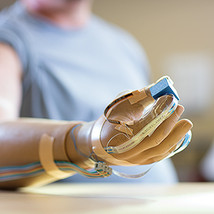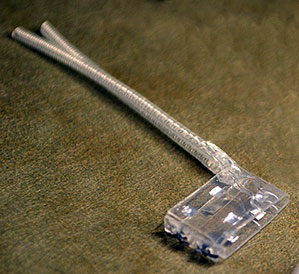/ News

An Artificial Hand with Real Feelings
There have been remarkable mechanical advances in prosthetic limbs in recent years, including rewiring nerve fibers to control sophisticated mechanical arms (see “A Lifelike Prosthetic Arm”), and brain interfaces that allow for complicated thought control (see “Brain Helps Quadriplegics Move Robotic Arms with Their Thoughts”). But for all this progress, prosthetic limbs cannot send back sensory information to the wearer, making it harder for them to do tasks like pick up objects without crushing them or losing their grip.
Now researchers at the Cleveland Veterans Affairs Medical Center and Case Western Reserve University have developed a new kind of interface that can convey a sense of touch from 20 spots on a prosthetic hand. It does this by directly stimulating nerve bundles—known as peripheral nerves—in the arms of patients; two people have so far been fitted with the interface. What’s more, the implants continue to work after 18 months, a noteworthy milestone given that electrical interfaces to nerve tissue can gradually degrade in performance.
A video produced several weeks ago shows a 48-year-old Ohio man who lost his right hand in an accident three years ago using his prosthetic hand to pick up and remove stems from cherries without crushing them from excessive squeezing. This was thanks to the new technology, which allowed force detectors on the digits of his prosthetic hand to convey touch information directly to three pea-sized nerve interfaces surgically implanted in his lower right arm. He controls the hand through a standard technology called a myoelectric interface, which uses signals from the muscles in his lower arm to govern prosthetic hand movements.
The work opens up the possibility that prosthetic limbs could one day provide enduring and nuanced feedback to humans, says Dustin Tyler, the Case Western professor behind the project.
Lee Miller, a professor of neuroscience at Northwestern University who was not involved in the research, says the achievement appears remarkable. “This is the greatest number of distinct touch sensations generated by peripheral nerve stimulation that I know of, and the 18-month-long stability is also unsurpassed,” Miller says. A paper on the work is being prepared, Tyler says.

Nerve center: This seven-millimeter long device, called a cuff electrode, can convey feelings from sensors on a prosthetic hand or fingers when attached to a peripheral nerve in the arm stump.
At the heart of the technology is a custom version of an interface known as a cuff electrode. Three nerve bundles in the arm—radial, median, and ulnar—are held in the seven-millimeter cuffs, which gently flatten them, putting the normally round bundles in a more rectangular configuration to maximize surface area.
Then a total of 20 electrodes on the three cuffs deliver electrical signals to nerve fibers called axons from outside a protective sheath of living cells that surround those nerve fibers. This approach differs from other experimental technologies, which penetrate the sheath in order to directly touch the axons. These sheath-penetrating interfaces are thought to offer higher resolution, at least initially, but with a potentially higher risk of signal degradation or nerve damage over the long term. And so they have not been tested for longer than a few weeks.
The cherry-grabbing test subject is Igor Spetic of Madison, Ohio. He lost his hand at his job when it was crushed in a drop-forging hammer while he was making an aluminum fitting for a jet engine. Now he’s got two small wiring harnesses protruding from a port in his upper right arm. At the lab, Tyler connects those harnesses to a device that generates the electrical signals that are sent to the cuff. This device, in turn, receives triggering information from sensors on his prosthetic hand.
His sensory feedback has only been felt in the lab so far, but Spetic professes amazement at his unique trial. “It’s real exciting to see what they are doing, and I hope it can help other people,” Spetic says. “I know that science takes a long time. If I don’t get something to take home, but the next person does, it’s all to the better.”
Researchers carefully place the implants to determine where Spetic perceives forces on his missing limb. Once installed, Spetic can detect sensations on several fingers and on the back and side of his missing hand, corresponding to inputs from the prosthetic. Once the implant is in place, the sensations always seem to arise in the same spots, and do not shift around, Spetic says.
Tyler can tune the electrical signals sent to the cuff to produce a variety of sensations. Spetic says sometimes it feels like he’s touching a ball bearing, other times like he’s brushing against cotton balls, sandpaper, or hair.
Tyler says the sensations Spetic reports are more natural and useful than the vague buzzing feeling that earlier experimental technologies had often produced. This means it may be possible to customize a sensation so that the patient feels like he’s touching a point of a pen, for example. Other groups and companies are working on better force detectors to attach to a prosthetic hand and generate such nuanced signals.
“[The] research is truly cutting edge and leading the world in terms of providing direct sensory feedback to amputees,” says Jack Judy, director of theNanoscience Institute for Medical and Engineering Technology at the University of Florida in Gainesville. Judy recently served as a program manager for the Defense Advanced Research Projects Agency, where he ran a program that sought to improve the performance and reliability of neural interfaces used to control prosthetic limbs for soldier amputees. At least 1,715 soldiers suffered amputations in the wars in Iraq and Afghanistan.
Other existing technologies provide sensory inputs directly to nerves. Cochlear implants, for example, stimulate the auditory nerve to restore hearing, and technologies for stimulating the vagus nerve—which runs from the brain stem to the chest and abdomen—can be used to treat epilepsy and even depression. However, “when it comes to stimulating nerves to provide an effective sense of touch in humans, there has been far less progress,” Judy says.
There are other approaches to sensory feedback, including efforts to do this directly through brain implants (see “Giving Prosthetics a Sense of Touch”). But brain implants are considered farther off because of the heightened safety concerns from opening the skull. The Case Western work is in a pilot feasibility trial, and Tyler says that if all goes well, a device could be on the market in five to 10 years.
Source: http://www.technologyreview.com/news/522086/an-artificial-hand-with-real-feelings/
/ About us
Founded by Russian entrepreneur Dmitry Itskov in February 2011 with the participation of leading Russian specialists in the field of neural interfaces, robotics, artificial organs and systems.
The main goals of the 2045 Initiative: the creation and realization of a new strategy for the development of humanity which meets global civilization challenges; the creation of optimale conditions promoting the spiritual enlightenment of humanity; and the realization of a new futuristic reality based on 5 principles: high spirituality, high culture, high ethics, high science and high technologies.
The main science mega-project of the 2045 Initiative aims to create technologies enabling the transfer of a individual’s personality to a more advanced non-biological carrier, and extending life, including to the point of immortality. We devote particular attention to enabling the fullest possible dialogue between the world’s major spiritual traditions, science and society.
A large-scale transformation of humanity, comparable to some of the major spiritual and sci-tech revolutions in history, will require a new strategy. We believe this to be necessary to overcome existing crises, which threaten our planetary habitat and the continued existence of humanity as a species. With the 2045 Initiative, we hope to realize a new strategy for humanity's development, and in so doing, create a more productive, fulfilling, and satisfying future.
The "2045" team is working towards creating an international research center where leading scientists will be engaged in research and development in the fields of anthropomorphic robotics, living systems modeling and brain and consciousness modeling with the goal of transferring one’s individual consciousness to an artificial carrier and achieving cybernetic immortality.
An annual congress "The Global Future 2045" is organized by the Initiative to give platform for discussing mankind's evolutionary strategy based on technologies of cybernetic immortality as well as the possible impact of such technologies on global society, politics and economies of the future.
Future prospects of "2045" Initiative for society
2015-2020
The emergence and widespread use of affordable android "avatars" controlled by a "brain-computer" interface. Coupled with related technologies “avatars’ will give people a number of new features: ability to work in dangerous environments, perform rescue operations, travel in extreme situations etc.
Avatar components will be used in medicine for the rehabilitation of fully or partially disabled patients giving them prosthetic limbs or recover lost senses.
2020-2025
Creation of an autonomous life-support system for the human brain linked to a robot, ‘avatar’, will save people whose body is completely worn out or irreversibly damaged. Any patient with an intact brain will be able to return to a fully functioning bodily life. Such technologies will greatly enlarge the possibility of hybrid bio-electronic devices, thus creating a new IT revolution and will make all kinds of superimpositions of electronic and biological systems possible.
2030-2035
Creation of a computer model of the brain and human consciousness with the subsequent development of means to transfer individual consciousness onto an artificial carrier. This development will profoundly change the world, it will not only give everyone the possibility of cybernetic immortality but will also create a friendly artificial intelligence, expand human capabilities and provide opportunities for ordinary people to restore or modify their own brain multiple times. The final result at this stage can be a real revolution in the understanding of human nature that will completely change the human and technical prospects for humanity.
2045
This is the time when substance-independent minds will receive new bodies with capacities far exceeding those of ordinary humans. A new era for humanity will arrive! Changes will occur in all spheres of human activity – energy generation, transportation, politics, medicine, psychology, sciences, and so on.
Today it is hard to imagine a future when bodies consisting of nanorobots will become affordable and capable of taking any form. It is also hard to imagine body holograms featuring controlled matter. One thing is clear however: humanity, for the first time in its history, will make a fully managed evolutionary transition and eventually become a new species. Moreover, prerequisites for a large-scale expansion into outer space will be created as well.
Key elements of the project in the future
• International social movement
• social network immortal.me
• charitable foundation "Global Future 2045" (Foundation 2045)
• scientific research centre "Immortality"
• business incubator
• University of "Immortality"
• annual award for contribution to the realization of the project of "Immortality”.



 LinkedIn
LinkedIn
 LiveJournal
LiveJournal
 Google
Google
 Twitter
Twitter
 Facebook
Facebook
 Я.ру
Я.ру
 ВКонтакте
ВКонтакте
 Mail.ru
Mail.ru